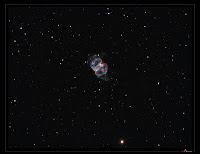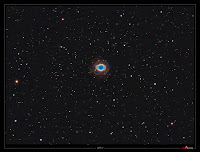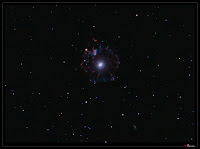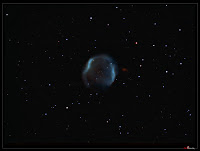COPYRIGHT, PLEASE NOTE
All the material on this website is copyrighted to J-P Metsavainio, if not otherwise stated. Any content on this website may not be reproduced without the author’s permission.
BUY A MUSEUM QUALITY POSTER
BUY A POSTER:https://astroanarchy.zenfolio.com/
Monday, February 21, 2011
IC 1848, the "Soul Nebula", as an anaglyph Red/Cyan 3D
You'll need Red/Cyan Eyeglasses to be able to see this image right.
Note, if you have a Red and Blue filters, you can use them! Red goes to Left eye.
Other 3D-formats:
Original 2D:
NOTE! This is a personal vision about forms and shapes, based on some known facts and an artistic impression.
Labels:
anaglyph images and movies
Sunday, February 20, 2011
Sh2-132, project finalized
Sh2-132, an emission nebula in Cepheus
Ra 22h 19m 20s Dec +56° 06′ 00"
Image is in HST-palette, (HST=Hubble Space Telescope) from the emission of ionized elements, R=Sulfur, G=Hydrogen and B=Oxygen. Star colors are mixed from the NB channels, Red=H-a, G=O-III and B= 85%O-III + 15%H-a.
Sharpless 132 is a very faint emission nebula, it locates at the border of Cepheus and Lacerta. Distance is about 10.000 light years. This image covers about 210' x 160', that's about 3,5 x 2,7 degrees. Resolution is 3,79 arc seconds/pixel.
In this final version, a strong O-III area is visible as a Blue color in both color palettes. There is some S-II in the area too but it's weak.
Natural color composition from the emission of ionized elements, R=80%Hydrogen+20%Sulfur, G=100%Oxygen and B=85%Oxygen+15%Hydrogen to compensate otherwise missing H-beta emission. This composition is very close to a visual spectrum.
With this image, I had my QHY9 and the Tokina AT-X 300mm f2.8 lens perfectly perpendicular to each others. Due that, the image is very sharp, there is no sharpening or star reduction methods used.
At f2.8, everything hast to be perfect, collimation, focus and orthogonality. The critical focus zone is only about 14 microns at this optical speed. If it's missed at all, the sharpness of the image collapse. At perfect focus, light ends up in a pixel, if focus is missed, even lightly, light will fall to all nine pixels, not just one!
The temperature compensating focuser, TCF-s, works as a heart of my DIY lens focusing system. It keeps focus perfect at all night when ambient temp. drops, typically 15 or more degrees up here. (Half a degree drop is enough to destroy the focus.) You can see my focusing device here:
http://astroanarchy.blogspot.com/2008/09/new-equipmets-and-some-development-work.html
A closeup
An experimental starless version as an animation
The purpose, of this animated image, is to show the actual nebula complex under the dense star field .
Processing work flow:
Image acquisition, MaxiDL v5.07.
Stacked and calibrated in CCDStack.
Levels, curves and color combine in PS CS3.
Equipments:
Tokina AT-X 300mm f2.8 @ f2.8
Platform and guiding, Meade LX200 GPS 12" @ f5
Camera, QHY9
Guider, Lodestar
Image Scale, 3,79 arc seconds/pixel
Exposures:
Baader H-alpha 7nm 12x1200s, binned 1x1
Baader O-III 8,5nm 12x600s, binned 2x2
Baader S-II 8nm 10x600s, binned 2x2
Friday, February 18, 2011
APOD
![[nasa-large.jpg]](https://blogger.googleusercontent.com/img/b/R29vZ2xl/AVvXsEhnPTKmnidt6gHuVkChO_MPYTqp2lSu-Tr0If3ey1qfJxF9BJpDhG8wIWnxo86hb3vT5OYKiznVUminjBaRRat99o70A1ODvDjHEDHpKGWYCsnjn-WFYunaGVPsfXiizriH0upX9hbpNWs/s1600/nasa-large.jpg)
-
My Planetary Nebula poster was selected as an "Astronomy Picture of the Day" by the NASA. You can see the NASA page here: http://apod.nasa.gov/apod/ap110218.html
-
This was my Third APOD, previous ones can be seen here:
http://apod.nasa.gov/apod/ap090131.html
http://apod.nasa.gov/apod/ap090131.html
Note! There is now a Gray circle, size of the full Moon, as a scale.
I made this poster to show and understand relative sizes of the nebulae. All Planetary Nebulae in this image are in same scale. Each individual image covers an area of 20' horizontally. (~0,3 degrees) and
they are in "natural" colors, mixed from the narrowband channels. By a following method:
Natural color composition from the emission of ionized elements, R=80%Hydrogen+20%Sulfur, G=100%Oxygen and B=85%Oxygen+15%Hydrogen to compensate otherwise missing H-beta emission. This composition is very close to a visual spectrum.
I have made a similar poster out of supernova remnants as well, you can see it from here:http://astroanarchy.blogspot.com/2011/02/supernova-remnant-poster.html
I have made a similar poster out of supernova remnants as well, you can see it from here:http://astroanarchy.blogspot.com/2011/02/supernova-remnant-poster.html
All images, except NGC 6302 (Bug Nebula), are shot from my urban observatory in very centrum of city Oulu. NGC 6302 was shot with a remote telescope, 16" RCOS, from Australia.
All of the images are Planetary Nebulae.
Planetary nebulae are shells of gas, shed by stars late in their life cycles after using up all of their nuclear fuel. The gas is illuminated and ionized by its extremely hot central star, a core left from the original star.
Our own star, the Sun, is expected to undergo the same process in a couple of billion years.
Images, from top Left to a bottom Right
Click thumbnails for large images, technical data behind links
Click thumbnails for large images, technical data behind links
M27, the "Dumbbell Nebula":
M76, the "Little Dumbbell Nebula":
http://astroanarchy.blogspot.com/2010/11/m-76-little-dumbbell-nebula.html

PK 164+31.1, Jones-Emberson 1:

PK 164+31.1, Jones-Emberson 1:
M57, the "Ring Nebula":
http://astroanarchy.blogspot.com/2010/10/m57-ring-nebula-project-finalized.html

Sh2-188:
http://astroanarchy.blogspot.com/2010/11/sh2-188-project-finalized.html
NGC 6543, the "Cat's Eye Nebula":
http://astroanarchy.blogspot.com/2010/10/m57-ring-nebula-project-finalized.html

Sh2-188:
http://astroanarchy.blogspot.com/2010/11/sh2-188-project-finalized.html
NGC 6543, the "Cat's Eye Nebula":
http://astroanarchy.blogspot.com/2011/01/cats-eye-nebula-reprocessed.html

Sh2-274, the "Medusa Nebula":
http://astroanarchy.blogspot.com/2011/02/medusa-nebula-sh2-271-project-finalized.html
Jones 1:
http://astroanarchy.blogspot.com/2010/11/jones-1-extreme-dim-planetary-nebula.html

NGC 6302, the "Bug Nebula":

Sh2-274, the "Medusa Nebula":
http://astroanarchy.blogspot.com/2011/02/medusa-nebula-sh2-271-project-finalized.html
Jones 1:
http://astroanarchy.blogspot.com/2010/11/jones-1-extreme-dim-planetary-nebula.html

NGC 6302, the "Bug Nebula":
Labels:
publications
Thursday, February 17, 2011
New project, Sharpless object 132, Sh2-132
Sh2-132, an emission nebula in Cepheus
Ra 22h 19m 20s Dec +56° 06′ 00"
Bi-color composition from the emission of ionized elements, R=100% Hydrogen, G=100%Oxygen and B=85%Oxygen+15%Hydrogen to compensate otherwise missing H-beta emission. This composition is very close to a visual spectrum.
This is a start of the new project. I will shoot more O-III and a S-II channel later.
This is a start of the new project. I will shoot more O-III and a S-II channel later.
Sharpless 132 is a very faint emission nebula, it locates at the border of Cepheus and Lacerta. Distance is about 10.000 light years. This image covers about 210' x 160', that's about 3,5 x 2,7 degrees. Resolution is 3,79 arc seconds/pixel.
With this image, I had my QHY9 and the Tokina AT-X 300mm f2.8 lens perfectly perpendicular to each others. Due that, the image is very sharp, there is no sharpening or star reduction methods used.
At f2.8, everything hast to be perfect, collimation, focus and orthogonality. The critical focus zone is only about 14 microns at this optical speed. If it's missed at all, the sharpness of the image collapse. At perfect focus, light ends up in a pixel, if focus is missed, even lightly, light will fall to all nine pixels, not just one!
The temperature compensating focuser, TCF-s, works as a heart of my DIY lens focusing system. It keeps focus perfect at all night when ambient temp. drops, typically 15 or more degrees up here. (Half a degree drop is enough to destroy the focus.) You can see my focusing device here:
http://astroanarchy.blogspot.com/2008/09/new-equipmets-and-some-development-work.html
A closeup
No sharpening or star reduction methods used
An experimental starless version as an animation
The purpose, of this animated image, is to show the actual nebula complex under the dense star field .
Processing work flow:
Image acquisition, MaxiDL v5.07.
Stacked and calibrated in CCDStack.
Levels, curves and color combine in PS CS3.
Equipments:
Tokina AT-X 300mm f2.8 @ f2.8
Platform and guiding, Meade LX200 GPS 12" @ f5
Camera, QHY9
Guider, Lodestar
Image Scale, 3,79 arc seconds/pixel
Exposures:
Baader H-alpha 7nm 12x1200s, binned 1x1
Baader O-III 8,5nm 36x200s, binned 1x1
Subscribe to:
Comments (Atom)





















